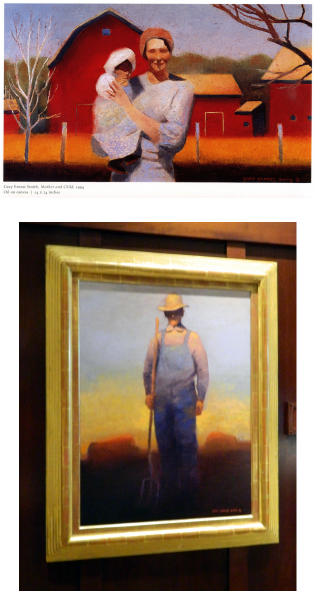
To your right you see the registration desk, with its mica shaded lamps, and note an unusual bronze sculpture at home on the granite counter top. This sculpture is none other than Perry native Snick Hamlin’s cartoon character Alley Oop, interpreted in bronze by artist Gary Ernest Smith. Smith’s art is seen throughout the Hotel Pattee in various public spaces, as well as in executive offices.
A respected painter, Smith’ rural icons radiate the warmth of sun-baked soil, the broad stretch of limitless sky, and the rough texture of harvested fields. And his paintings are often enlivened by images of those who lived the land. “I like to find the beauty in real simple things,” Smith says. I never thought painting fields would have any significance at all. But since I started doing that, I have so many people coming to me and saying, ‘I’ve never looked at fields the same way I’m looking at them now.”
As to his figurative work, he explains that it is symbolic, with shadowed faces and simplicity replacing detail. Smith is often asked about paintings in which faces are left without specific features. “It universalizes the figures,” he explains, “which represent not individuals so much as a collective group of people. You can read into the painting whatever you want to.”
A respected painter, Smith’ rural icons radiate the warmth of sun-baked soil, the broad stretch of limitless sky, and the rough texture of harvested fields. And his paintings are often enlivened by images of those who lived the land. “I like to find the beauty in real simple things,” Smith says. I never thought painting fields would have any significance at all. But since I started doing that, I have so many people coming to me and saying, ‘I’ve never looked at fields the same way I’m looking at them now.”
As to his figurative work, he explains that it is symbolic, with shadowed faces and simplicity replacing detail. Smith is often asked about paintings in which faces are left without specific features. “It universalizes the figures,” he explains, “which represent not individuals so much as a collective group of people. You can read into the painting whatever you want to.”

Smith speaks in similar terms about landscape. “Over the years the varied landscapes of America have continued to offer meaningful symbols to me…light and shadows play across landscape, creating abstract shapes and moods. Hay bales are placed in fields as if man and nature were working in design harmony. Interesting lines of planted or plowed furrows indicate both intriguing form and function. I find myself somewhere between traditional and contemporary art, and my work kind of reflects that. I want to show the positivism of life..…..above all else, I want my paintings to be positive.”
The overreaching theme of Smith’s work is the land; he endeavored to express his desire to put people back in touch with the land. He feels that those who live on the land are closely tied to the seasons, noticing change and growth. Smith’s paintings are about the earth, “where we come from and where we’re going when this is all over.”
Behind the registration desk, your eyes are drawn to Gary Ernest Smith’s Mother and Child; note the vagueness of both mother and child’s facial features, very representative of Smith’s work. The barn and out-buildings take us back to another era, when life revolved around the farm.
To the left of the doorway we see another oil by Gary Ernest Smith, in this piece, Sunsets in the Fields, once again the principal has unspecific facial features. The farmer’s hard working face is obscured in shadows cast by his hat.
The overreaching theme of Smith’s work is the land; he endeavored to express his desire to put people back in touch with the land. He feels that those who live on the land are closely tied to the seasons, noticing change and growth. Smith’s paintings are about the earth, “where we come from and where we’re going when this is all over.”
Behind the registration desk, your eyes are drawn to Gary Ernest Smith’s Mother and Child; note the vagueness of both mother and child’s facial features, very representative of Smith’s work. The barn and out-buildings take us back to another era, when life revolved around the farm.
To the left of the doorway we see another oil by Gary Ernest Smith, in this piece, Sunsets in the Fields, once again the principal has unspecific facial features. The farmer’s hard working face is obscured in shadows cast by his hat.

